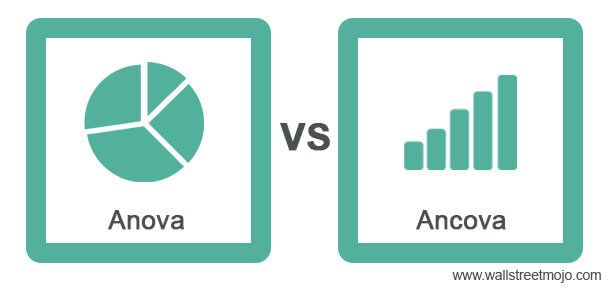Table Of Contents
Difference between ANOVA and ANCOVA
In ANOVA vs ANCOVA, ANOVA stands for Analysis of Variance, and ANCOVA stands for Analysis of Covariance. The primary difference between both methods used to analyze the variance in the mean values is that the ANCOVA method is used when there are covariates (denoting the continuous independent variable), and ANOVA is appropriate when there are no covariates. In essence, in ANOVA, the independent variables are all of the categorical types, and In ANCOVA, the independent variables can be categoric and continuous types.

Key Takeaways
- In ANOVA vs ANCOVA, the ANOVA neglects the effect of covariates, whereas ANCOVA considers and controls the effect of covariates.
- It points to one of the answers to the question, "what is the difference between anova and ancova."
- Other statistical methods like MANOVA are often compared with ANOVA and ANCOVA.
- In one-way or two-way ANOVA vs ANCOVA vs MANOVA, ANOVA stands for Analysis of Variance, ANCOVA stands for Analysis of Covariance, and MANOVA stands for Multivariate Analysis of Variance.
ANOVA vs ANCOVA Infographics

What is Anova?
Anova stands for Analysis of Variance, and it involves the analysis of differences in group means and the difference of variances. It is used when three or more groups are involved in the study. It uses between and within-group variance differences. The researcher analyses the variance across the means of groups taken in the statistical test. The test results prove or disprove the occurrence of statistically significant differences between the means compared.
The Anova test is either one-way or two-way based on the input data. A one-way ANOVA has one independent variable, whereas a two-way ANOVA has two independent variables. With the help of the Anova test, any claim, situation, or statement can be either accepted or rejected by a researcher.
ANOVA vs ANCOVA comparison points to the significance of the careful selection of null and alternative hypotheses. In an Anova test, the null hypothesis will be like "the means of three groups are all the same," and the alternative hypothesis states that "the means of three groups are all different," or "minimum one of the means of three groups are different." If the means of any one or two groups differ, the null hypothesis is rejected, and the alternative hypothesis is accepted.
Consider an example in which the researcher analyses the impact of diet on weight loss. First, the researcher divides the total number of participants into three groups. Then, each group follows different diets for three months under the guidance of a professional trainer. At the end of the third month, all of the participants take the test to determine weight loss, and completing the ANOVA test based on the result helps to know whether or not the diet type has an impact on weight loss by checking for statistically significant difference between the mean scores of the three groups.
What is ANCOVA?
ANCOVA stands for Analysis of Covariance, which can be understood as an extended process of the Anova test. Ancova makes use of a combination of ANOVA and regression. For instance, if all the independent variables act as covariates, ANCOVA turns into regression analysis; hence it exemplifies a hybrid of Anova and regression analysis. The test considers and controls the covariates' effect, enhancing an experiment's correctness. Covariates are certain characteristics of the test participants that are not relevant to the study. But it has the potential to affect the response variable (result).
Consider an anova vs ancova example. ANCOVA could be used, for example, in a study to test the effects of treatment using a specific drug on a specific disease in participants of varying ages. Here the factor or categoric independent variable is the treatment, age act as a continuous independent variable, and the change in the disease condition after treatment is the dependent variable or response variable. At the same time, ANOVA could be used if the age is not signified as a metric or continuous independent variable. In that case, the focus is on treatment (factor or categoric independent variable) and the change in the disease condition after treatment (dependent or response variable).
Statistical methods like regression analysis and MANOVA are often compared with ANOVA and ANCOVA. MANOVA is similar to ANOVA but contains more than one continuous response variable, unlike ANOVA with one response variable. In regression vs ANOVA, the factor in regression can be continuous predictor variables, whereas ANOVA uses categorical predictor variables to analyze the outcome.
Comparative Table
| Particulars | ANOVA | ANCOVA |
|---|---|---|
| 1. Stands for | Analysis of Variance | Analysis of Covariance |
| 2. Meaning | It is a statistical method to test the variance or differences between the means of three or more groups. | It evaluates the mean of a dependent variable based on a categorical independent variable while considering and controlling the effects of covariates. |
| 3. Uses | Can blend linear and nonlinear models. | A linear model is used alone. |
| 4. Involves | Categorical independent variables. | Categorical and metric independent variables. |
| 5. Covariate | Neglects the influence of covariates. | Considers and controls the effect of covariates. |
Similarities
- Both involve the analysis of means of multiple groups.
- Both methods accept categorical variables.
- ANCOVA contains the application of ANOVA.
- Both the tests were introduced by a British statistician named Ronald Aylmer Fisher and mentioned elaborately in his classic book

